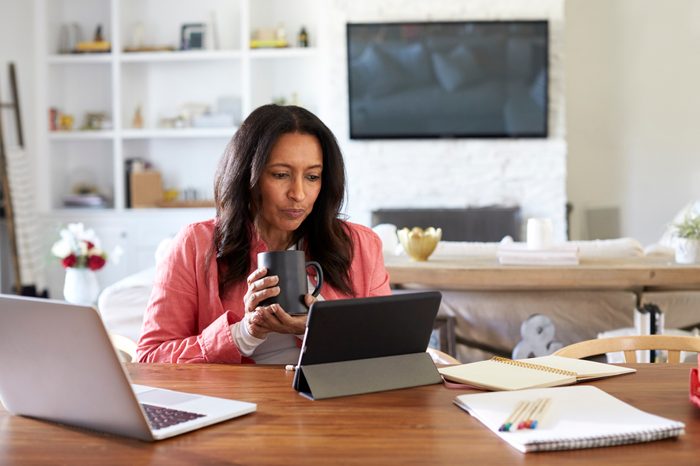
Working from home is the new normal
The Covid-19 pandemic has created an indefinite work-from-home set up for many Americans. That means not only sharing workspace with whomever else you live with, but it can also mean the couch has now become your office. Awesome, right? Kind of, until a few days in you notice that you just can’t get comfortable or you just can’t find your focus. There’s also the danger that you start working until late at night, unable to put away the work when it’s right there at arm’s length.
Better concentration and comfort are just a few of the reasons why it’s important to set up an optimal workspace for yourself. “Your workspace is important not just for productivity, but also for your long-term mental and physical health,” explains Cameron Yuen, a physical therapist at Bespoke Treatments Physical Therapy in New York, New York. “An individualized ergonomic setup can help with focus, headaches, neck pain, and back pain. Postural neck and back pain especially are tough to recover from if you are forced to work from a poor set up.” A healthy set up will spill over into other areas too—it can boost your energy, ease pain and soreness, and improve your mood.
We spoke with Yuen and other wellness experts to learn how to set your workspace up for success at home.
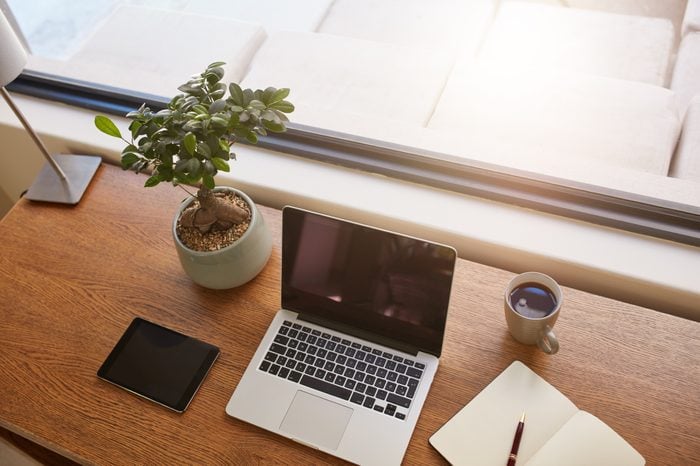
Have a designated work area
Most people won’t have the luxury of designating a room for work. Still, you’re better off creating some separation between where you work and where you typically unwind and relax in the evening. “To keep motivation and focus stronger during work time, try to choose a more tucked away spot that’s away from distractions,” says Julie Groveman, a licensed psychologist in Manhattan.
Do your best to set up boundaries to avoid having your office, living area, and meals all in the same spot. “If you have the space to do it, separate each of these areas, so you have more room to move around and you don’t feel so ‘stuck’ in one spot all day,” says Rachel Goldman, clinical psychologist, and clinical assistant professor in the department of psychiatry at New York University Grossman School of Medicine. “Setting up an area that works for you is in your control, even if you are limited to a small space. You know yourself best and what you need to function at your best. Take the time to assess that and then create it.” Be creative: Even if you need to work at the kitchen table, try to do it in a different chair than the one you typically sit in to eat.
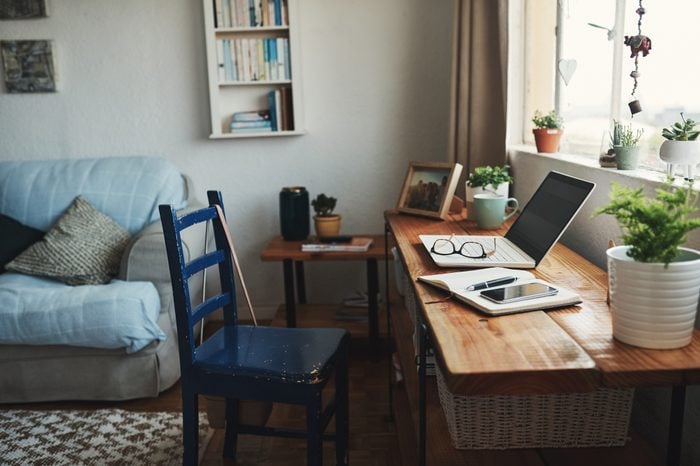
Consider a desk and chair set up
Since you may be working at home for the foreseeable future, if you have space, try to create a desk and chair set up (or consider purchasing a desk and chair if you have the means). Just try to avoid working on the couch. “As with all ergonomics, you want to make your environment fit you and your own needs, and not the other way around,” suggests Yuen. So if you’re sitting at a higher desk or table, you want to be able to adjust your height to fit at that table. “You don’t want to have to contort your body because your chair is too low,” says Yuen. “Instead, you want a chair that you can adjust up and down to fit your workspace. If you have a larger desk or an angled desk, you will also want a chair that can rotate with wheels so that you can move your entire body rather than repeatedly rotating from your spine. This variability makes an office chair superior to a recliner.” Check out these ergonomically-friendly office chairs for back pain that will give you the correct support.
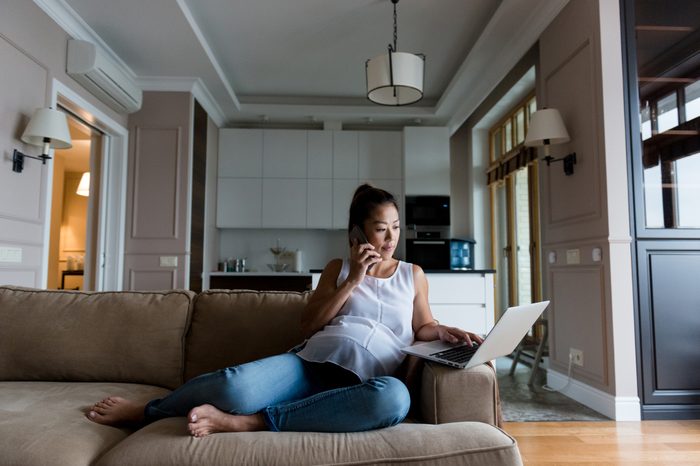
If you have to work on the couch…
When the sofa is your only or best option, that’s okay, says Yuen. You just have to pay attention to your position. “Try to vary your posture throughout the day,” he advises. “If you are always reclined with your feet up, your back and neck may eventually start bothering you.” His suggestion—move every hour to a different posture. “If you are going to stay in one position for an extended period, place a pillow or crunch up a blanket behind your lower back, and elevate your laptop on several books or a pillow rather than just resting it on your lap.”

Keep your screen at a healthy height
No matter where you’re sitting, it’s important to have your monitor at an optimal height—even if you’ve opted to stand. “If your monitor is too high, it’s more likely that you will strain the joints of your neck as you are looking up for prolonged periods,” says Yuen. “More often though, the monitor is set too low, which causes your head to flex and extend forward, which also causes your upper back and shoulders to round forward. This can lead to a sore neck and shoulder muscles over time.” And bad posture can hurt your overall health.
Yuen recommends that your monitor be eye height. And if you’re going to be working from home for a while and have the means, you may want to consider investing in a monitor. “Without a monitor, it’s impossible to raise your laptop screen to an appropriate height without also raising your keyboard,” says Yuen, unless you opt for an external keyboard and mouse. (More on that below.)
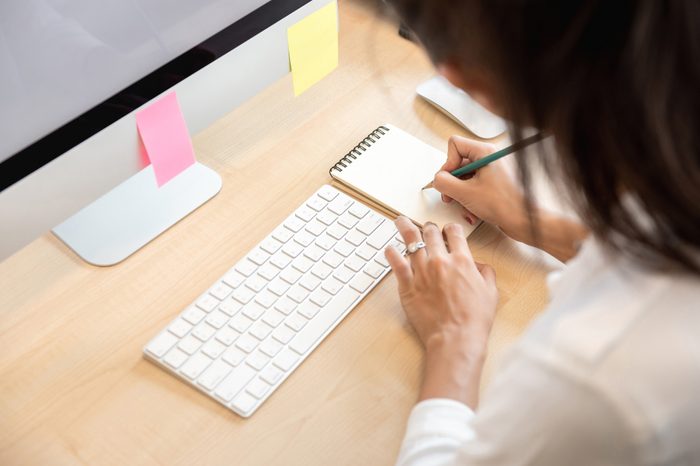
Use an external keyboard and wrist support pad
Typing and emailing for hours on end may end up causing you wrist pain, or it could exacerbate it if you have underlying wrist issues, like carpal tunnel. “The wrist joint is relatively small, but requires multiples tendons, nerves, veins, and arteries to travel through it,” says Yuen. “If you keep your wrist in an extended position for too long, some of these structures can get irritated.”
When your wrist feels weak or uncomfortable an external keyboard and wrist pad could solve the issue. “A separate keyboard and wrist pad aren’t necessary for most people,” says Yuen. “However, if you have a history of wrist or elbow pain, it is worth considering. You will want to try keyboards and pads that keep your wrist just slightly flexed.” You can also comfortably prop up your laptop to an appropriate screen height if you use an external keyboard and mouse, too.
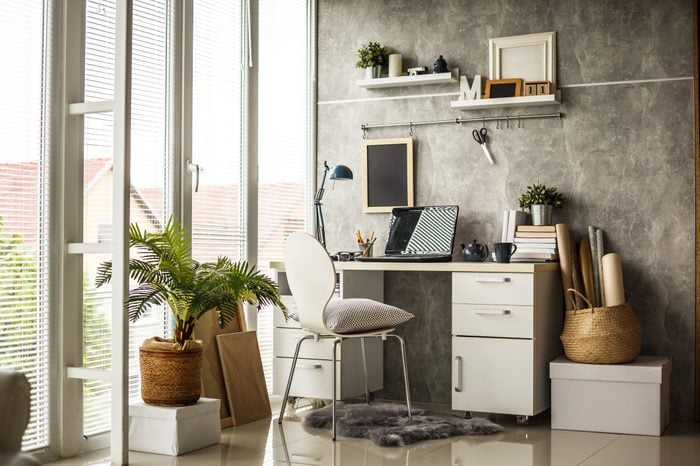
Prop up on a pillow
You may be more likely to sit for longer periods at home than you would in your office building: No heading out for lunch, walking down the hall for meetings, or hanging out at the water cooler. The good news is there are ways to recover from sitting for so long.
Take a good look at your chair: “A lumbar pillow will help keep the natural curve of your spine,” explains Yuen. “This doesn’t mean you always want to be in a neutral spine, but most people tend to excessively flex their spine and then stay there the entire day.”
If you’re using a standing desk and have a good upright posture, keep doing what you’re doing. But if you’re sitting for hours on end and getting a little lazy, you may want to consider a fix. “I would recommend a lumbar roll for anyone who sits all day regardless of whether they are at home or at the office,” says Yuen. “Even if your back doesn’t bother you, it can be a good reminder to vary your posture, and it can help give the muscles of your low back a break.” Yuen recommends the McKenzie roll since you can hook it around a chair, and it’s the right size for a neutral lumbar spine position, he says. If you don’t want to buy lumbar support, roll up a towel or blanket and use that instead! (This is what working from home does to your body.)
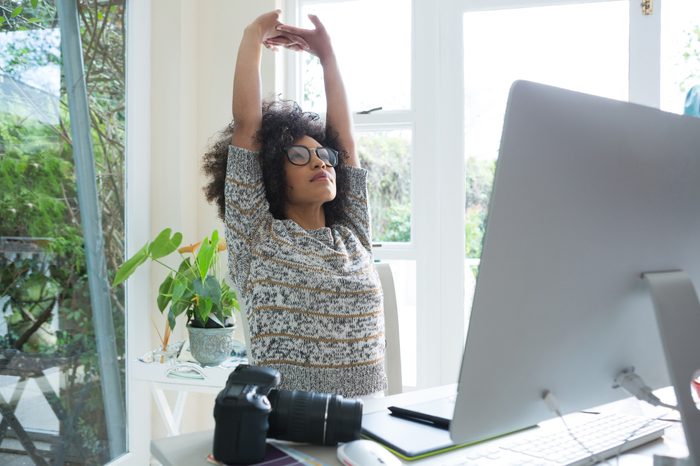
Create structure with routine
Since you know with a good deal of certainty that you’ll be working at home for the next few months, take this as an opportunity to set routines. Groveman suggests beginning and ending your day purposefully. “Get in the habit of a morning routine that signals the start of the workday like showering, or getting dressed, or taking a few minutes to meditate,” she says. “End your day similarly by changing out of your ‘work’ clothes—even if you’re just wearing sweats—and take an evening walk or close your eyes and take some deep breaths.” These actions symbolize the transition in and out of your workday. “Routines are simple habits to help you gain some control especially helpful during this uncertain time,” explains Groveman. (These loungewear sets are both comfortable and stylish—the perfect combo for the work-from-home life.)
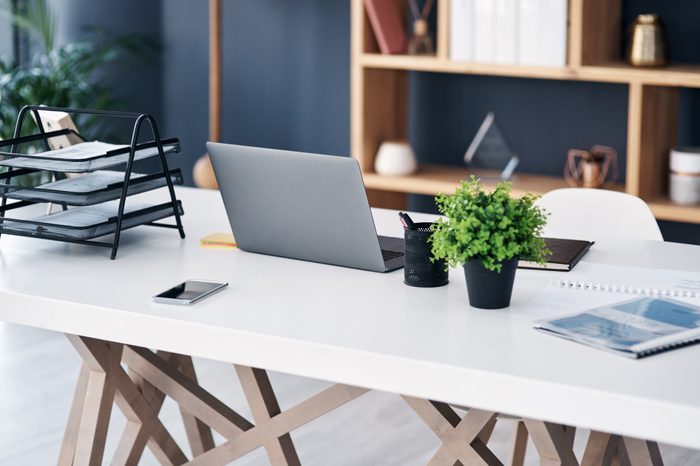
Organize your workspace
You’ve probably been sheltering in place for a few weeks now, but that doesn’t necessarily mean you’ve dedicated any time to setting up and organizing your workspace. Take the time to do it now, recommends Goldman: “Designate time in your day to clean your corner or space and organize your work area. The time it takes to get better organized is going to pay off once you get set up in your space as it will allow you to have better focus and therefore be more productive.”

Be sure you’re still getting up and moving
If you’re living in an apartment, especially a small one like a studio, getting up to grab lunch from the fridge or use the bathroom doesn’t make for much walking. Have you checked your fitness tracker or watch lately? Are you getting enough steps? Chances are good that you’re not, which is why it’s important that you make it a point to stand up and move around.
“As you sit throughout the day, your muscles tend to shorten, fluid tends to accumulate in your legs, and your joints get stiff,” says Yuen. “Take 10 minutes every hour to move, get the blood pumping again, and loosen up your muscles and joints. It’s good for both your body and your mind.” Need a way to keep track? Set an alarm on your phone or watch to go off every 50 minutes or so, and then take 10 minutes to do some calisthenics, take a walk around the block, or try a brief yoga session.

Shut down at the end of the day and leave your workspace
When the workday is over, that means the workday is over. Just because working at home is the new norm, that doesn’t mean that all your time at home should be spent working. Respect your time off by turning off your computer and work email and chats. This is why having a separate workspace is ideal: You can close your computer and walk away from your computer and work for the night.
“If those two spaces are in the same room, or if you bring your computer into your relaxation area and you see your inbox on your computer start to fill up with emails, you are going to be tempted to go and check your email and work will be constantly on your mind,” explains Goldman. “This can be very taxing on your brain and it will feel like you are never able to ‘turn off.’ We all need to have that separation, as we need to destress and relax.” Don’t miss these other tweaks for a healthier workspace.

